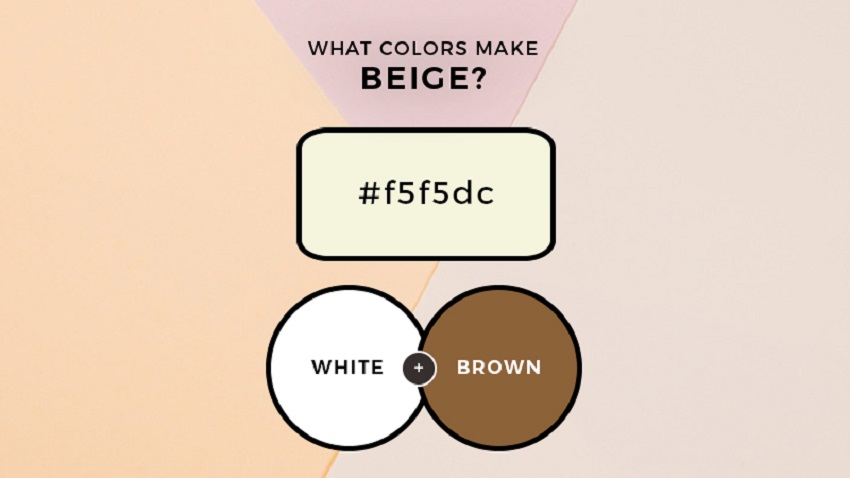How to make beige? Step by step guideline

Many colors present in the chromatic circle make it possible to differentiate tones that are very similar to each other but with enough nuances to distinguish them. Having all these colors is essential for artists since to do the works, they need as many as possible: only then can they accurately represent what they want to reflect in their creations.
The basic colors are the easiest to differentiate and elaborate on because they are the best known, but others are more specific and are the result of the mixture of primary or secondary colors. Among them, beige is a very particular color whose creation has several options. If you want to know how to make beige, the necessary mixtures to obtain it, and the procedures that must be followed in each type of paint to achieve it, we recommend that you continue reading this practical article.
How to make beige?
The beige color is also known in some places as cream color and, other times, they are considered to be different shades of the same color. Depending on the paints used to make it, it is obtained with different shades, but two types of mixtures can be established. If you want to know how to make the cream color, keep in mind which colors to mix to make beige or cream:
The first is to use pure white paint as a base and add just a yellow paint drop. The yellowish hue serves to turn the white base into a beige or cream color. This color can easily vary depending on the combination, so you will have to practice with the mixture and the quantities of each color until you get the beige tone you were looking for.
The second way you can go to create beige is to use a white base paint and add two tones in small quantities: light yellow and brown. The latter will provide a different shade to that obtained with the first option and pigeonholed among the cream-colored tones.
Make beige with tempera
Among the different paints with which you can create beige are tempera. Follow these steps to make beige with tempera:
- In all color mixing options, to create this color, you will need a white paint base.
- Starting with a large quantity of white paint, add a few drops of yellow and optionally brown paint (depending on the beige color you want). If the tempera is a tube, include each color in a palette and, if they are, can use different brushes to avoid staining the cans of each painting with other tones. Remember to apply a small amount of water to the brush to get the paint you need and the tone you prefer.
- Use a brush again to mix the paints to a homogeneous beige color.
- Remember that the tempera material allows you to vary the color made after drying. How? Very simple: you will only have to wet the brush a little before passing it over the paint again. Thus, you can make a new mixture and tone the beige or cream tone previously created.
Make beige with acrylics
You can also prepare beige with acrylic paint. You just have to comply with these steps:
- Select an all-white paint and use it as a base for mixing. Some kits of this type of paint indicate it as a “pure white” color on the label.
- Depending on the type of drawing or craft you are doing, on a canvas or on the palette, add a wide line of white paint (3 or 4 seconds). On the sides, add another smaller line of light yellow paint (1-2 drops) and optionally the same type of fine line but brown paint (1 drop).
- With a brush, mix all the paint until you get the beige color. Depending on the distribution of quantities that you have made, you will get one tone or another of this color.
Make beige with toners or dyes
Making the beige color with toners is one more alternative and is widely used to paint beige or cream walls. These toners are used to tint many paint types such as plastic, vinyl, latex, acrylic, or water. To make the beige color with toners or paint tints correctly, we recommend you follow these steps:
- Choose a white base paint.
- You cannot add more than 60 cubic centimeters (cc) of stain for every liter of white paint. Otherwise, the paint will lose adhesion on different surfaces and generate dye stains by not completely dissolving.
- If you have a liter of white paint, add a maximum of 30cc of yellow dye to get the beige color. For every 4 liters, you will have to add 120 cc of dye.
- With a paint mixer, mix the stain and white paint until you get a cream color.
Make light beige color
The beige color can have two different tones depending on its clarity and can be lighter or darker. If you intend to make a light cream shade, do not use the brown paint and use the base of white with a very small amount of basic yellow or, in any case, use it in a color that is already light yellow. In this way, you will know how the sand color is made in paint since the light beige tone resulting from this mixture will resemble that of light sand.
Bearing in mind that, for all the tones that you want to lighten, you will need to use white. In this case, it will be even easier since it is the color used as the base to make the mixture. Therefore, to achieve the desired hue and remain a light tone, we recommend using only light yellow tones or in a small amount and adjusting the amounts of each color in the mixture as you see the result until you achieve the tone you were looking for. Other very common tones that start from the beige color and become lighter are the off-white color, the ivory color and the champagne color.
Make dark beige color
If you want to make a dark beige color, bet firmly on the second alternative mentioned at the beginning of this article, that is, by adding the brown paint to the mix. This shade will provide a greater contrast to the base mix’s white and yellow color, creating a darker shade. You can add more of this shade of brown or less depending on how dark you want the beige color.








